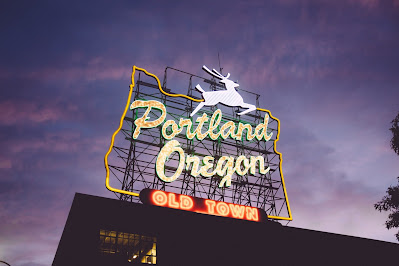Oregon Prayer Spotlight: Portland - Part 1
Thus says the Lord:“Stand in the ways and see, and ask for the old paths, where the good way is, and walk in it then you will find rest for your souls..."
Usually we focus a Spotlight on lesser-known or out-of-the-way communities in Oregon, but this time we want to look at Portland, the state’s largest metropolitan area, situated at the confluence of the Willamette and Columbia Rivers.
If you google religion and Portland, you get numerous headlines declaring it the most unchurched and non-religious city in the country.
It was not always so.
A lot happened in the 1840’s. Settlers began coming to Oregon on the Oregon Trail, many farmers drawn by a PR campaign that promoted the rich, fertile land in the Willamette Valley. Some of those early settlers included Asa Lovejoy and Francis Pettygrove who are well known for flipping a coin in 1845 to determine the name of the town they were establishing on their 640 acres along the Willamette River. Pettygrove of Maine won the toss and named it Portland.
The little town of Portland grew quickly as a business center and shipping port. In 1850 it had a population of around 800 which grew to 8,000 or so by 1870. The California gold rush of 1849 did a lot to help those early businesses thrive, creating a demand for Oregon wheat, cattle and other farm products, as well as lumber to build the booming gold towns of northern California. Also in 1850 the Oregon Donation Land Claim Act created an incentive for those farmers – many family men - to move west and take up farming in the lush Willamette Valley, which in turn created more products to ship and supplies to provide by the merchants and businessmen of Portland. Those early builders of Portland were entrepreneurs who came with some financial backing and educated ideas on how to build a city. Asa Lovejoy, for example, was an attorney in Boston, Massachusetts before going to Oregon. George Abernathy, the first provisional governor of Oregon, came with Methodist missionary Jason Lee’s group termed the “Great Reinforcement” in 1840.
Pioneers like these created a social climate in Portland in those early years – 1840 -1870 – different from the wild and wooly gold-rush communities of California which were established by adventurers seeking gold and silver.
For a fascinating look at Portland history, Barney Blalock’s book, The Oregon Shanghaiers: Columbia River Crimping from Astoria to Portland is very informative. Referring to those very early years, he quotes Samuel Bowles, Our New West, published in 1870:
The population of Portland is now from eight to ten thousand, who keep Sunday with as much strictness almost as Puritanic New England does, which can be said of no other population this side of the Rocky Mountains at least.
 |
| Portland waterfront, 1870 |
But by the turn of the century - thirty years later - Portland had a reputation for being the most dangerous seaport in the world, wide-open with corruption, prostitution, gambling, drugs...and, of course, shanghaiing.
What happened?
In 1870 Portland was officially made a seaport, and about that time the Army Corp of Engineers began the long-term task of dredging the Columbia and Willamette Rivers to give larger sea-going vessels access to Portland. They increased the depth of the Columbia River all the way to Astoria. This increased the need for crews for ocean-going ships.
Crimping, or supplying sailors for ships, attracted a different type of entrepreneur than the Puritan New Englanders, Methodists, and mid-western farmers who came to Oregon over the Oregon Trail. Crimping was a business with ties to organized crime and racketeering, and as Portland grew as a seaport and a city, crime and corruption, alcohol, drugs, and prostitution overwhelmed the city’s ability to deal with it.
I highly recommend Blalock’s book for a look at how things really worked. There have been a number of myths and some misinformation surrounding the shanghaiing of sailors, but the truth gives a lot of insight into how Portland changed and developed.
How do we pray for Portland?
For we do not wrestle against flesh and blood, but against principalities, against powers, against the rulers of the darkness of this age, against spiritual hosts of wickedness in the heavenly places. Ephesians 6:12
My research has left me with a number of thoughts. One is that the flesh and blood racketeers and crimps left. Shanghaiing sailors is no longer a thing in Portland – those flesh and blood people are long gone – but human trafficking, which their treatment of the sailors strongly resembles, is a big problem in Portland. The original traffickers left, but the spirit lives on. Perhaps that is where we should focus our prayers.
Next: Portland did not stay “the most dangerous port in the world.” In part 2 we will look at some surprising events that happened in Portland, and the world at large, at the start of the twentieth century.
Margaret




Comments
Post a Comment